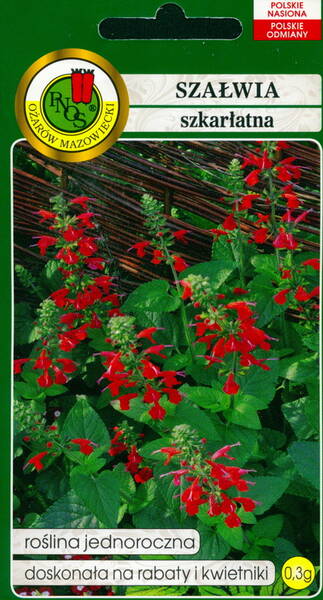Your shopping cart is empty!
Scarlet sage (blood sage)
Blood sage (scarlet sage) - Salvia coccinea Buc'hoz ex Etl.
An annual up to 60 cm high with bright scarlet-red flowers, which are collected in a racemose inflorescence 15-30 cm long. Flowers in whorls of 4-8 pieces. Corolla red, about 3 cm long, with a long tube.
Grown in seedlings. To obtain seedlings, sowing is carried out in February-March. Shoots appear on the 10-15th day. Seedlings are planted in early June, after the end of spring frosts, the distance between plants is 30 cm.
Prefers sunny areas with loose, moderately fertile soils, can grow in partial shade. Abundant flowering from June to frost.
Used for planting in flower beds and garden decoration.
Sage care consists in systematic weeding and periodic loosening of the soil. The high drought tolerance of plants allows them to be watered infrequently, even in the sun. However, with prolonged drought, they still lose their decorative effect (leaves sag, inflorescences become faded) and need abundant watering.
Sage practically do not require top dressing - they grow and bloom well if you apply complex mineral fertilizers at the beginning of the growing season. It is best to feed them until they bloom or within 1 month after planting at intervals of 10-15 days.
Regular removal of wilted and damaged inflorescences contributes to the preservation of decorative properties and a longer flowering of Sage.
An annual up to 60 cm high with bright scarlet-red flowers, which are collected in a racemose inflorescence 15-30 cm long. Flowers in whorls of 4-8 pieces. Corolla red, about 3 cm long, with a long tube.
Grown in seedlings. To obtain seedlings, sowing is carried out in February-March. Shoots appear on the 10-15th day. Seedlings are planted in early June, after the end of spring frosts, the distance between plants is 30 cm.
Prefers sunny areas with loose, moderately fertile soils, can grow in partial shade. Abundant flowering from June to frost.
Used for planting in flower beds and garden decoration.
Sage care consists in systematic weeding and periodic loosening of the soil. The high drought tolerance of plants allows them to be watered infrequently, even in the sun. However, with prolonged drought, they still lose their decorative effect (leaves sag, inflorescences become faded) and need abundant watering.
Sage practically do not require top dressing - they grow and bloom well if you apply complex mineral fertilizers at the beginning of the growing season. It is best to feed them until they bloom or within 1 month after planting at intervals of 10-15 days.
Regular removal of wilted and damaged inflorescences contributes to the preservation of decorative properties and a longer flowering of Sage.
Eng.: Scarlet sage, Blood sage. Bot. syn.: Salvia pseudococcinea Jacq.












